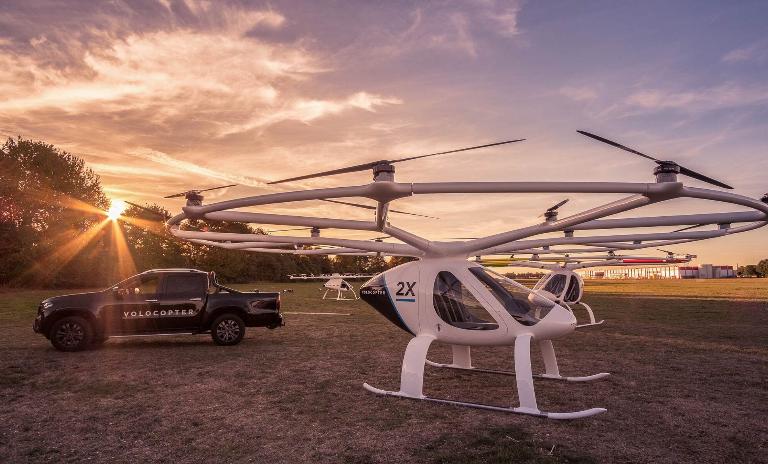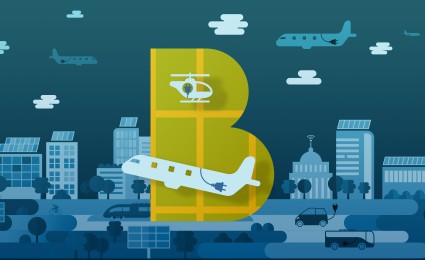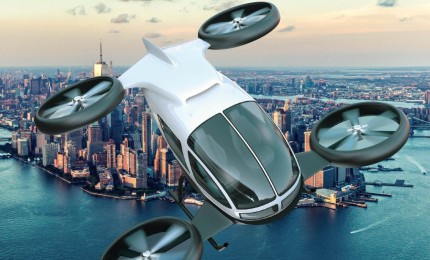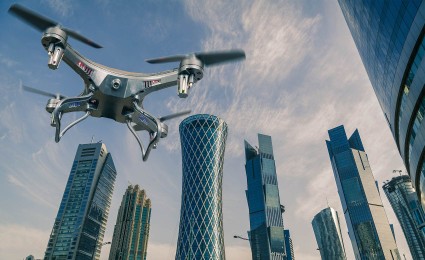

Volocopter CTO: First air taxi route to open in the next 2 - 5 years
Safety, low noise emission and low operating cost are crucial factors in the acceptability of air taxis
Urban Air Mobility (UAM) seems on track to becoming commercial reality within the next decade, adding a third dimension to urban mobility. Air taxis connecting airports with city centers are expected to be the first use case, followed by intra-city and then inter-city routes. A dozen different players have already reached an advanced technological stage in the manufacturing of passenger drones. Industry focus is now on overcoming hurdles in the areas of safety and certification and on creating take-off and landing infrastructure.

One key player in the UAM market is Volocopter, a German manufacturer of passenger drones. We spoke to Chief Technology Officer Jan-Hendrik Boelens about his expectations for this new mode of transportation.
In your recently published white paper "Pioneering the Urban Air Taxi Revolution" you came to very similar conclusions as we did in our study "UAM - The rise of a new mode of transportation", i.e. that there is no single best eVTOL (electric vertical take-off and landing) concept, because the use case / mission is key when designing eVTOLs. Which use cases do you believe will start commercial operations first and when? And which concepts will succeed for which use case?
One of the most obvious use cases is the airport-to-city center route. We believe there is much demand here and it is a feasible route to offer. Our research has shown that we can serve this route with our current Volocopter model in roughly 90 percent of relevant megacities worldwide. We believe that the first air taxi route will be opening in the next two to five years. Where exactly that might be, we do not know yet. Generally, multicopter designs like Volocopter will be strongest in the inner-urban mission, as this technology’s biggest strengths are low noise emissions during take-off and landing, and high energy efficiency at short range. Tilt-rotor and fixed-wing air taxis will be better suited for connecting cities with one another. These designs could also connect remote areas to the city outskirts.
"We do not want to offer a new form of mobility for a few rich, but rather for anybody who nowadays could afford a taxi."
The Volocopter is designed for commercial intra-city UAM usage. What factors will be key for success for air taxis serving this purpose?
Safety, low noise emission and low operating cost are crucial factors in the acceptability of air taxis. That’s why these are key considerations in the design of our Volocopter. While the multicopter design will not allow us to offer long distances in the near future, it ensures the lowest noise emission in the industry and a very stable flight. Our Volocopters are easy to get into, spacious and the user experience is at the top of our mind. This combined with the certifiability of our design puts us in a good spot for offering urban air taxis.
Is Volocopter focusing exclusively on intra-city UAM usage or are there any plans to design concepts for other purposes as well?
Urban Air Mobility is our clear focus at Volocopter. This is our chance to change how we move about our cities and add a new dimension to urban transportation . Nonetheless, we do explore further applications of our technology.
While technological developments are already quite advanced, the topics safety and certification are seen as the main hurdles. What is your view on this and what can be done to accelerate necessary developments and decisions in these fields?
The largest hurdle has been taken. EASA published the Special Condition for VTOLs on July 2, 2019. This is the basis necessary to make UAM product certification a reality. Now it is a question of diligent work and rigor to achieve the required and necessary levels of safety for commercial operations. In addition, continued close cooperation with authorities is required on other regulatory aspects like crew licensing, certifying vertiports, and several other aspects related to operations.
Collaboration between different stakeholders (manufacturers, regulators, operators, municipalities, universities, etc.) will be key to foster the development and the commercial operation of UAM. In which areas is Volocopter cooperating with a partner? What are the milestones you've reached and what key learnings can you share?
We will be working with several partners in the different markets to cover the entire UAM value chain. Currently we are working with Skyports to develop and realize UAM infrastructure. We are already building the first VoloPort with Skyports this year and will unveil this before the year is over. This prototype will allow us to test the user journey, as well as service and maintenance processes and further the conversation with the regulators to certify VoloPorts as aerodromes in the future.
Infrastructure is a critical aspect of making UAM a reality - not only physical but also digital infrastructure. To this end we are part of a EU-funded demonstration project in the Gulf of Finland. As part of this consortium we are integrating with different UTM (Unmanned Aircraft System Traffic Management) service providers and perform live tests with the systems, ultimately showing that air taxis integrate well with proposed UTM solutions. We also cooperate with universities like the University of Stuttgart, and even with other eVTOL OEMs through special interest groups like EUROCAE and GAMA.
Beyond that we are cooperating with Fraport to evaluate how air taxis can be integrated in operating airports and are part of the CAA UK’s regulatory sandbox. Generally, we see that there is great interest in UAM by cities and other players; even regulators are excited about the topic.
Currently a dozen different players have reached an advanced technological stage in the manufacturing of passenger drones: Large aircraft OEMs like Airbus and Boeing, helicopter manufacturers like Bell, Startups like Volocopter and Lilium which are backed by strategic investors, etc. Do you expect a concentration or do you believe that completely new players will enter the market?
As different players are evolving from the prototype stage to the product development stage, the cost of developing and certifying an actual product, including the infrastructure for operating it, will likely lead to a concentration of the industry, while newcomers will find it difficult to catch up and secure sufficient funding. I expect that the incumbents like Airbus and Boeing will choose not to be first movers, but rather to be “fast followers”. That said, the UAM market is global and has very big potential. We do not expect it to be a winner-takes-all market, so there will be space for many providers. Some of them will even supplement one another with different missions.
In your study you mention that "Keeping operating costs low to build a scalable business will allow for accessible pricing. What would be your definition of accessible pricing"? And what are the key levers to bring operating costs down and keep them down?
The lower we can keep costs the more accessible the service becomes. Most importantly, we do not want to offer a new form of mobility for a few rich, but rather for anybody who nowadays could afford a taxi. Scaling production and service to offer more rides/hour will be a significant factor in bringing costs down. Apart from that, battery cost is one of the driving cost factors, particularly due to the low number of useful cycles current battery technology can offer. This is one of the reasons why we are opting for a battery swap system. This will increase the life cycle of our batteries significantly and thus decrease costs. Looking into the future, once air taxis can be made to fly autonomously, there is more potential for reducing cost, both by not incurring cost related to crew salaries, and by distributing fixed cost over more seats per flight.
Would you like to know more about how your company can prepare for Urban Air Mobility? Please don't hesitate to connect with our experts Manfred Hader , Stefan Unteregger and Stephan Baur .






